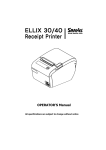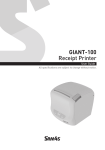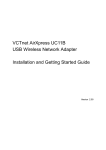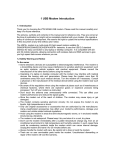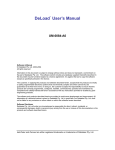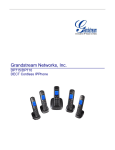Download User Manual Manager Invitel
Transcript
Invitel Manager User Manual Copyright © 2009 by ZTE Corporation All rights reserved. No part of this publication may be excerpted, reproduced, translated or utilized in any form or by any means, electronic or mechanical, including photocopying and microfilm, without the prior written permission of ZTE Corporation. The manual is published by ZTE Corporation. We reserve the right to make modifications on print errors or update specifications without prior notice. Edition 1st edition, May 2009 Content 1 USB Wireless Data Card Introduction ...................................................................... 1 1.1 Introduction.................................................................................................................... 1 1.2 Safety Warning and Notice ........................................................................................ 1 1.3 Applicability Scope ...................................................................................................... 2 1.4 System Requirements................................................................................................. 2 1.5 Functions........................................................................................................................ 3 2 Installation .................................................................................................................. 3 2.1 Connect the Wireless Data Card and PC ............................................................... 3 2.2 Running Application Software.................................................................................. 3 2.3 Disconnect Wireless Data Card Safely................................................................... 4 2.4 Software Uninstallation .............................................................................................. 4 3 Functions & Operation............................................................................................... 4 3.1 Interface Introduction.................................................................................................. 4 3.2 Connecting to the Internet ......................................................................................... 5 3.3 Settings ........................................................................................................................... 6 3.4 Phonebook ..................................................................................................................... 9 3.5 SMS ................................................................................................................................ 10 4 Help ........................................................................................................................... 11 1 USB Wireless Data Card Introduction 1.1 Introduction Thank you for choosing the ZTE Wireless Data Card. To guarantee the Wireless Data Card always in its best condition, please read this manual carefully and keep it for future use. The pictures, symbols and contents in this manual are just for your reference. They might not be completely identical with your Wireless Data Card. Please subject to the real object. ZTE operates a policy of continuous development and reserves the right to update and modify the technical specifications in this document at any time without prior notice. ZTE Wireless Data Card is a type of multi-mode, 3G Wireless Data Card, applicable to GSM/GPRS/EDGE/WCDMA/HSDPA network. It integrates some functions of Wireless Data Card and mobile phone, and combines mobile communication with the Internet perfectly. Via GSM/GPRS/EDGE/WCDMA/HSDPA mobile network, it carries out data service, helping you break away from limitation of time and zone, and communicate wirelessly anytime and anywhere. 1.2 Safety Warning and Notice To the owner ! Some electronic devices are susceptible to electromagnetic interference sent by Wireless Data Card if inadequately shielded, such as electronic system of vehicles. Please consult the manufacturer of the device manufacturer before using the Wireless Data Card if necessary. ! Operating of your PC and Wireless Data Card may interfere with medical devices like hearing aids and pacemakers. Please always keep Wireless Data Card more than 20centimeters away from such medical devices when they are in use. Power off Wireless Data Card if necessary. Consult a physician or the manufacturer of the medical device before using Wireless Data Card. 1 ! Be aware of the usage limitation when using a Wireless Data Card at places such as oil warehouses or chemical factories, where there are explosive gases or explosive products being processed. Do not use Wireless Data Card if necessary. ! Store the Wireless Data Card out of the reach of small child, it may cause injury if used as a toy. USB Wireless Data Card ! Please use original accessories or accessories that are authorized by the manufacturer. Using any unauthorized accessories may affect your Wireless data Card’s performance, and violate related national regulations about telecom terminals. ! Avoid using the Data Card near metallic structure device or establishment that can emit electromagnet wave. Otherwise it may influence receiving of signals. ! The Wireless Data Card is non-waterproof, please keep it dry and store in shady and cool place. ! Don’t use the Wireless Data Card immediately after sudden temperature change. In such case, there will be dew inside and outside the Wireless Data Card, so don’t use it until it becomes dry. ! Treat the Wireless Data Card carefully. Don’t drop, bend, knock or harshly treat it to avoid destructive damage. ! No dismantling by non-professional and only qualified maintainer can undertake repair work. In Aircraft ! Please power off the Wireless Data Card before the airplane takes off. In order to protect airplane’s communication system from interference, it is never allowed to use the Data Card when it is in flight. Using it before the plane taking off should get aircrew’s permission according to safety regulations. 1.3 Applicability Scope The ZTE Wireless Data Card supports Apple computers and laptops. 1.4 System Requirements 2 Operating System: Version 10.4 or above Configuration: CPU PowerPC or Intel Processor 500M or above Memory 128M or above The performance of the Wireless Data Card may be influenced if configuration under recommendation required. 1.5 Functions Functions support includes: Data service, Applications management, etc. 2 Installation 2.1 Connect the Wireless Data Card and PC Connect Modem with your PC. Double click the install package of the software, then follow the following steps to install: 1) Press “Continue” button on the welcome page. 2) Select a destination volume to install software on the volume “Macintosh HD”, and then click “Continue”. 3) Select Installation Type ”Customize” or “Easy Install”, and then click ”Install”. 4) Please enter user name and password to be authenticated, and left click “OK” to install. 5) Click “Continue Installation” make sure that installing requires user to close. 6) Left click “Close” to finish software installation. Note: If you have problems with installation after the upper operation, please contact the service provider for help. After the installation, select “Finder” ! “Applications” and there will be a “Invitel Net’n’Go Manager” program listed in, the Wireless Data Card is ready to work normally. 2.2 Running Application Software 3 After the Wireless Data Card is installed and connected normally, double click Finder !Applications!Invitel Net’n’Go Manager on the PC to run the application software. 2.3 Disconnect Wireless Data Card Safely Please quit the application software first, and then pull out the Wireless Data Card. 2.4 Software Uninstallation Close the application program before the software uninstalling. Select Finder!Applications!Uninstall Invitel Net’n’Go Manager to uninstall the software. 3 Functions & Operation 3.1 Interface Introduction The Mac PC application software comprises into three parts!Functional Button Area, System Information Area and User Area. The related functions can be executed by within the corresponding area. 3.1.1 Functional Button Area There will be various functional button icons shown in this area. Select different function button and it will carry out corresponding operation. Connect to the Internet. Save and view different information of the contact list. Send SMS or read SMS in InBox/OutBox/Draft. Set normal relative information for the application software. View related information for your operation, such as, connect name, start time, disconnect time, duration, data received and data transport. 4 System information for Help. 3.1.2 System Information Area Shows the system status and related information. Shows network signal intensity, 6 stages from none to strong Letter “P” means supporting packet-switch (P) service, while letter “C” means supporting circuit switch (C) service. Indicates insert status of the Wireless Data Card or mobile card, “Green” it has been connected to the computer, and red indicates disconnected. Indicates insert status of the SIM/USIM card to the mode. Green indicates the card has been inserted, and red indicates not been inserted. 3.1.3 User Area Show the interactive computer information under various conditions. 3.2 Connecting to the Internet You can browse web pages after you have accessed to Internet through the Wireless Data Card. 3.2.1 Connect to the Internet Click button to ensure the wireless Data Card connect to Internet properly, you’d better configure user’ network information first. You can save different operator’s network configurations in different files. The user configuration information includes: Description (Config filename), Telephone Number, Account Name, Password, APN, DNS, and PDP address. If network support “Obtain server address automatically”, the Wireless Data Card can obtain the assigned IP information automatically. If network do not support it, you should fill the proper address manually. Please consult the network supplier of SIM/USIM card for all above information. The user configuration information may differ with the network 5 supplier and network types. And then click “Connect” to start connecting Internet. When connected, and it will show all the information of data flow, connected time and so on. During the course of connecting, you can “Cancel” the connecting. With connection in success, the button “Connect” becomes “Disconnect”. Note: The Wireless Data Card has the function of locking the SIM/USIM card. If you use the SIM/USIM card provided by the other network service provider, maybe you can’t connect to the network. If you have any problem, you can consult your network service provider for further information. 3.2.2 Disconnect the Internet Click “Disconnect” button to disconnect Internet. With disconnection in success, the button “Disconnect” becomes “Connect”. 3.2.3 Internet Log button, and switch to the Internet log interface. You can view related Click information for your operation, such as connect name, start time, disconnects time, duration, data received and data transport. 3.3 Settings Click button to switch to the settings interface. It includes: Security setting, Network settings, SMS setting, Alert setting, Browser setting and System setting. 3.3.1 Security Setting 1. PIN Enable You can enable the PIN Code verification by select PIN Enable. When PIN Enable item is selected, you will be asked to enter PIN code to use the modem. Click “Revise PIN” to modify the PIN Code. Enter the old PIN code and the new PIN code, click OK to confirm. 6 Note: This function needs network support. 2. Backup/Restore the Contacts and SMS You can backup the contacts and SMS in your PC. And you also can restore them. If you want to use this function, you need select the Backup/Restore the Contacts and SMS item first. And then click the Backup button to backup the contacts and SMS, or click the Restore button to restore the contacts and SMS 3.3.2 Network Setting 1.Operator Selection Automatic!The system selects the network automatically according to user’s configuration rules and network status. Manual! User selects network in manual way. Select network “Automatic”. The system will find the network available automatically. Select network “Manual”, and then select the preferred mode. After a while, network operator list appears in which red ones are unavailable. Select the proper network to connect. 2. Preferred Mode Automatic: The system selects the available network automatically. 3G Only: The system will only select the 3G network. 2G Only: The system will only select the 2G network. 3.3.3 SMS Setting Message Center: Set the corresponding SMS center number. You must input the correct SMS center number to use the SMS properly and the number will be provided by the network provider. Please enter the country code before the number. Validity period: Set the time limit for saving SMS in the network side. (This function needs network supports.)In option!12 hours/A day/A week/A longest period. The default setting is a longest period permitted by the network. 7 Delivery Report: Set “Turn On” or “Turn Off”. When it is set as “Turn On”, the network will inform you of the status for the sent messages. Location of Saving New SMS: Select “PC” to save in laptop or desktop PC; select “(U)SIM” to save in SIM card. 3.3.4 Alert Setting You can set Connect alert, Disconnect alert and Incoming SMS alert by yourself. These alerts will sound on the PC side. The audio file supports MP3"WAV"WMA and MIDI format. Click the Browse button to replace the default audio file. If you select “Mute”, you cannot hear corresponding alert. 3.3.5 Browser Setting You can set your browser to launch a certain web page automatically. Click the pull-down arrow to select a web page address which you want to launch. Click Advanced to perform the following actions: ! Disable this function by selecting the Do not open the browser at connection startup item. ! Enter a new web page address in the Text box, and then click Add to add this web page address in Available links list. ! Select a web page address in Available links list, and then click Edit to edit this web page address. ! Select a web page address in Available links list, and then click Remove to delete this web page address. 3.3.6 System Setting 1. Auto ! Start with Operation System: When the OS starts up, it will launch the software automatically. ! Auto Start when device is available: When you plug the modem in your computer, 8 the OS will detect and recognize the modem and run the software automatically. ! Auto Connect: The software will connect the internet automatically. 2. Select Language You can select the language of the software from the pull-down list box. 3.4 Phonebook Click button to switch to the phone book interface. The phonebook information can be saved in PC or (U)SIM card. Each record includes Groups, contact Name, Mobile Phone, Office Phone, Home Phone and Email which it belongs to. 3.4.1 New Group You can add new groups in PC. But you can not add new groups in (U)SIM card. Click and name the new group in PC group folder tree. Select the folder group you want to add or edit information, and input all the information according to the prompt. On bottom left, e.g. it shows Cur:5 Max :1000: When the PC radio button is selected, it means: ! The PC capacity is 1000,and 5 contacts has been saved in PC. When the (U)SIM radio button is selected, it means: ! The (U)SIM capacity is 1000,and 5 contacts has been saved in (U)SIM . 3.4.2 Searching Records You can key in total or any part of the record characters or phone number you are searching for. The corresponding records or names’ information are listed, scroll to the record you want to view in details. Select records from the list and click to edit the information. 3.4.3 Buttons Description If any records are selected, you can carry out the following steps: ! Delete selected records. ! Edit the information of the selected record. ! CopyTo Copy the records information between PC and (U)SIM card. 9 ! Send message to the mobile phone numbers in the records. 3.5 SMS Click button to switch to the SMS interface and it shows the number of the SMS in the inbox, outbox and draft box. Click the button , or to enter relative interface. Save received SMS. Save sent SMS. Save SMS edited as draft in PC before sending or after failure. 3.5.1 Reading SMS Click button or SMS icon in system information area to read the SMS saved inInBox. Make use of the bottom menu buttons to Create New, Reply, Forward, Delete, or Save message(s). 3.5.2 Creating new message Click button to input the recipient’s number and content. Input the recipient’s number directly or select it from the phonebook, and then press “SMS” button. The recipient’s number(s) can be one or more, using “;” to separate. SMS text can not exceed 765 individual English characters (including English symbols) or 335 Chinese and English mixed characters. Click “Send” button to send the message. After sending successfully, the SMS will be saved into OutBox automatically. If sending fails, failure notification will appear, and the message will be saved in the Draft. Sending SMS while browsing the web If network supports, you can send short messages when surf on the Internet. Click button, enter the short message interface and send SMS in normal way. 10 3.5.3 SMS Interface Operating Guide Enter any of the InBox/OutBox/Draft to execute the following functions: ! Read: Read all the information of the short messages. (The content of short messages, sender’s phone number, sending date and time) ! Reply: Reply short message to the sender. ( OutBox / Draft do not have this item) ! Delete: Delete selected short message(s). ! Forward: Forward short message to the other recipients. ! SaveTo: Save the selected SMS from PC to (U)SIM or from (U)SIM to PC. The system indicates when USIM/SIM card is full (USIM/SIM cards differs in capacity). New message can only be received and saved till the user clear some short message(s) in USIM/SIM card inbox. 4 Help Click button on application interface to switch to help pop-up windows. Under “Help” subject, you can get the Wireless data Card information on functions introduction, installation and usage guide, versions and date of application software and hardware published, etc. 11














